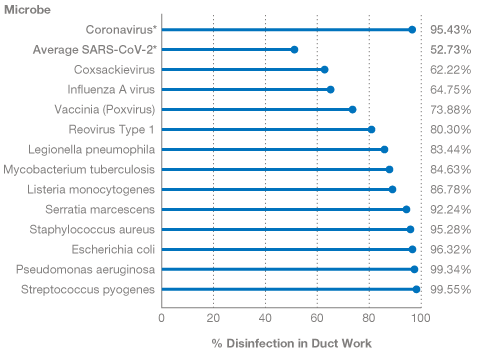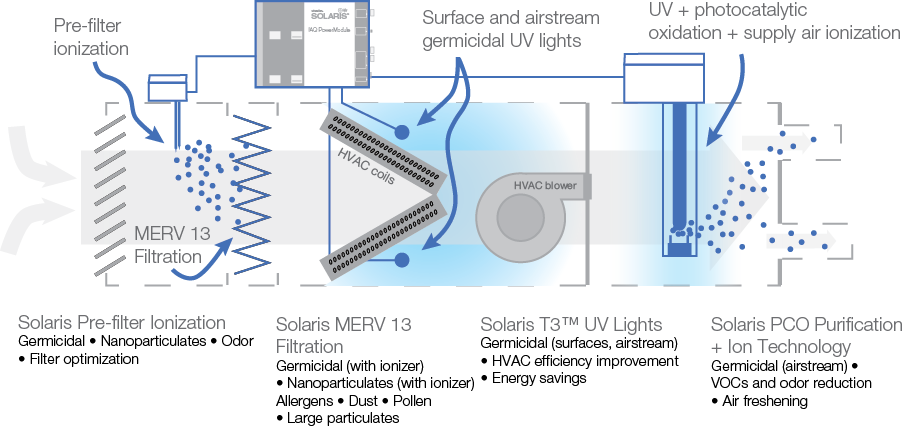UV Light | PCO Purification | Air Filtration | Ionization
About the use of Solaris® air purification and filtration products to help reduce the populations of microorganisms in indoor environments
UV light has been proven and in use for disinfection since the 1930s
While not that widely known for its usefulness, UV light technology for disinfection is not new. Ultravation, Inc. has been engineering UV-C disinfection products for residential and commercial applications for over 20 years. A major focus of our company is to design and manufacture devices that reduce or eliminate unwanted biological growth on air conditioning internal components. These include AC coils and blowers, drain pans and ductwork, as well as HVAC airstream sterilization, all using UVGI (ultraviolet germicidal irradiation).
Recognized by ASHRAE, the EPA and the CDC
UV technology is recognized and endorsed by the American Society of Heating, Refrigerating and Air-Conditioning Engineers (ASHRAE), the CDC and the EPA. In fact, it is the only air disinfection technology that is supported by (ASHRAE) as being effective. See ASHRAE Handbook—HVAC Applications, Chap. 62, Ultraviolet Air and Surface Treatment. In ASHRAE’s Pandemic Preparedness online advice, they state: “Consider adding air treatment and cleaning devices such as UVGI (ultraviolet germicidal irradiation) in duct, plenums and air handling units and on the face of cooling coils.” See https://www.ashrae.org/technical-resources/commercial#pandemic
How effective is UV specifically in deactivating microorganisms?
Germicidal UV-C light has been proven effective to inactivate many microorganisms. As noted above, ASHRAE acknowledges UV’s ability to destroy viruses, bacteria and fungi. In testing UV for the elimination of specific microorganisms, it is determined how much UV energy it takes and how long of an exposure time is needed for a given species to be inactivated. In the case of the coronavirus, SARS-CoV that caused the SARS outbreak in 2003, it was shown by 2004 that the virus was highly sensitive to germicidal UV light and kill-rate UV dose calculations were made. Today's data supports that the novel coronavirus SARS-CoV-2 that causes COVID-19 has similar UV sensitivity.
Engineering calculations for Solaris UV
Solaris UV lights, using Ultravation T3™ technology, emit up to 40% more germicidal energy and last twice as long as typical UV lamps. Engineering calculations have been made that show the anticipated performance of a Solaris IAQ Module operating two T3 UV lamps.

The percentage of disinfection in ductwork calculations are based on the intensity at the end of lamp life (18,000 hours).
* Many strains of coronavirus have been identified and tested for UV sensitivity. The chart lists two of these strains.
Solaris: A comprehensive approach to better air: UV combined with other technologies
From a practical standpoint, no single technology is an absolute answer in the purification of air. This is why we believe strongly in the multi-faceted approach we have taken for effective residential air treatment. In addition to UV, other technologies are utilized in Solaris IAQ products to address particulates, nano-particulates, allergens, odors as well as enhance disinfection through inactivation or simple removal.
Solaris MERV 13 filtration
MERV 13 level filtration is another step that can be taken to minimize viral exposure. The density of the fibers enables capture capability for particles the size of viruses for in-line filters in residential applications. MERV 13 is recommended by the ASHRAE Epidemic Task Force as an enhancement for HVAC systems for schools, colleges and universities. The State of New York requires MERV 13 or better filtration in all malls greater than 800,000 sq.ft. in its document "Interim Guidance for Malls During the Covid-19 Public Health Emergency".
Solaris Ionization
Bi-polar ionization is another technology that will contribute to air disinfection and "partners" well with filtration in two ways: Bi-polar ionization charges minute particles so they attract into large groups that are far more easily captured in a filter. Install just upstream of a filter in an HVAC system, a quality filter will capture a much high percentage of pathogens and other nano-particulates. The second benefit is that the emitted ions are germicidal so they disinfect the filter, making a full filter less of a hazard when removing and throwing away.
Solaris Photocatalytic Oxidation (PCO)
Solaris PCO technology purifies the air through oxidation using a patented titanium dioxide (TiO2) formulation that includes both silver (Ag) and zinc (Zn) ions, powered by UV light. The TiO2 absorbs UV light and the absorbed energy causes the release of electrons which bond with oxygen and water vapor creating strong oxidants that then combine with contamination, killing microbes of all types, and breaking down VOCs, odors and other chemical contamination.
HVAC systems offer multiple locations for disinfection opportunities.
Solaris IAQ uses them all.

Solaris air purification products are designed to improve indoor air quality and are not medical devices.
